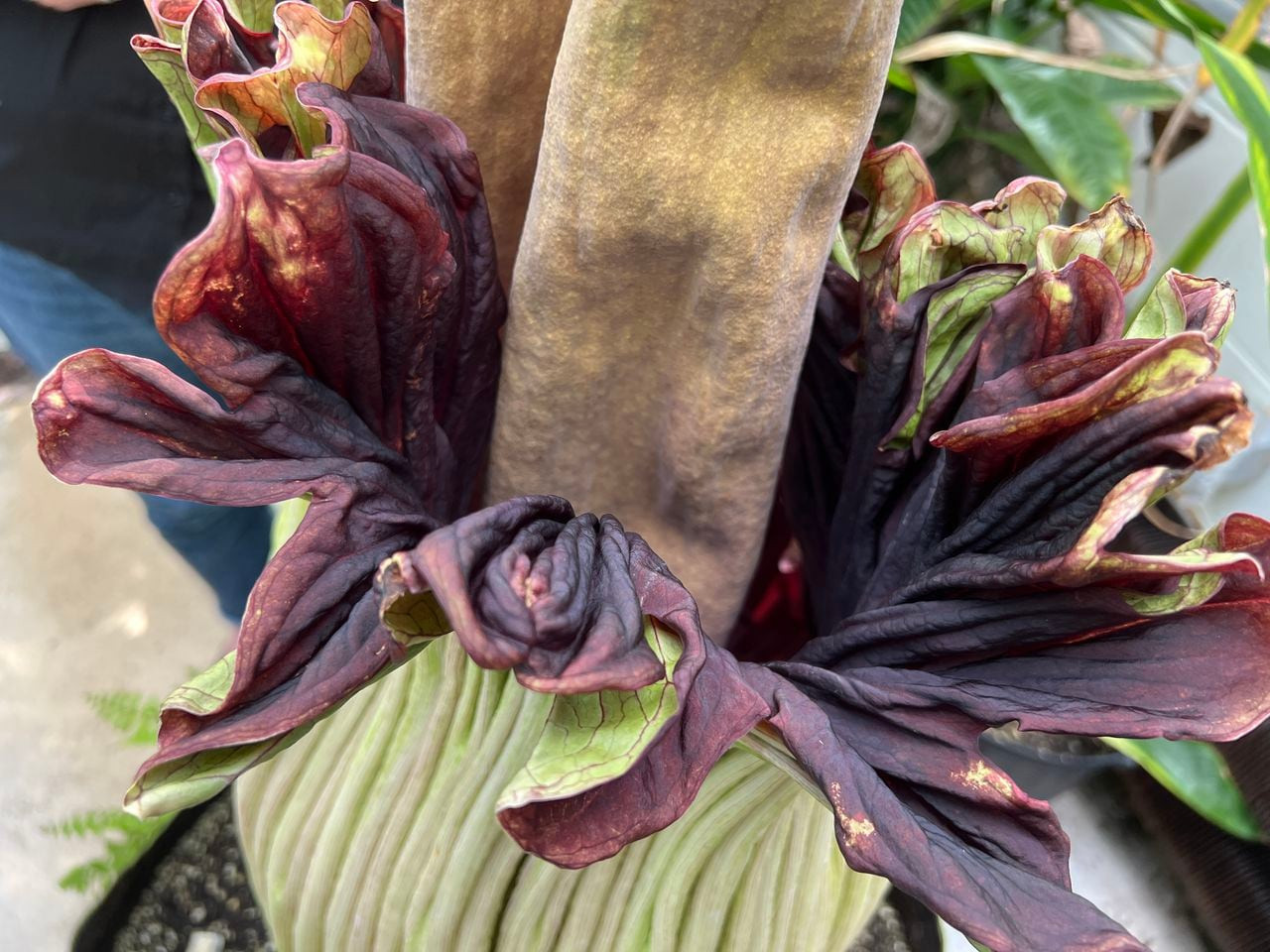Residents in Geelong, Victoria are gearing up for a once-in-a-decade event as a rare flower famous for smelling like rotting flesh begins to bloom. Geelong Botanic Garden is currently home to the corpse flower — Amorphophallus titanium or titan arum — an impressive plant native to the tropical rainforests of Sumatra in Indonesia.
The plant is famous for two fascinating characteristics — it blooms unpredictably, sometimes just once every 10 years and when it does, it smells like death. The corpse-like smell it releases attracts pollinators such as carrion beetles and flies and its giant leaf is a striking purple shade.
Adding to its allure, the rare bloom only lasts between 24 and 48 hours. Those keen to get a peak, and a whiff, of the plant have been urged to get down to the Geelong Botanic Garden quickly as the plant began its bloom on Monday morning. It should reach its full bloom over the course of about four hours. It will be the first time the plant has bloomed in Geelong.
Those unable to make it to the garden in person can watch the whole event via a livestream. City of Greater Geelong chief executive Ali Wastie described the event as a “once-in-a-lifetime experience”.
“The endangered titan arum is the largest species of carrion flower and its preservation is important as the wild population is in decline,” she said. “Since the bloom window is so short, don’t miss out on this once-in-a-lifetime experience and come see it for yourself at the Geelong Botanic Gardens.
“It’s been fantastic to see so many people interested in the titan arum and thank you to the thousands of people who have come to visit our iconic gardens in the lead-up to its blossoming.” While the corpse plant is in bloom, the Geelong Botanic Gardens will be open for 24 hours.
With Geelongians glued to the live stream updates and heading along to the Geelong Botanic Gardens hoping to witness the phenomenon in person, the corpse plant has officially begun to bloom, releasing its intense smell after a ten-year wait. With initial dates for the bloom projected between Tuesday 5 November to Sunday 10 November, the plant prolonged its blooming slowly growing in size and temperature, creeping up to temperatures of near 40 degrees, and releasing its frilled spathe.
The plant will stay in bloom for only 24 – 48 hours, releasing a powerful scent likened to rotting flesh, from whence its name is derived. To accommodate crowds, the Geelong Botanic Gardens will be open for 24 hours during the period of bloom. If you cannot make it to see the event unfold in person, or simply are not attracted the smell of rotten flesh, tune into the City of Greater Geelong live stream below.
The plant has attracted record numbers to Geelong Botanic Gardens in the lead up to the event with Saturday 9 November seeing 600 people visit the site. The live stream has attracted over 55,000 views, with a total watch time of over 9,500 hours so far with these figures set to spike during the bloom period.
Thousands of have already been to Geelong’s Botanic Gardens this week, hoping to see the Corpse Flower bloom. Geelong council staff have been keeping a close eye on what has become the most popular flower in the city. They believe the plant is getting ready to show its flowers, with the top of the frilly spathe turning red and slowly detaching from the stem. However once it blooms, there will only be a few days to see it in full display. The Corpse Flower is well known for having a distinct and rotten smell when it blooms. More than 3,300 people have been to the gardens in the last week hoping to catch a glimpse of the flower. A live stream has also been set up to see the flower in real time. You can see that here.
The scale of Trump’s electoral success and the red shift in Congress makes it clear that Americans have rejected the policies and priorities of the Democratic Party.
We inspire students to practice good global citizenship while strengthening their own communities. You can invest in our future leaders.
Act Now We’re sorry, this feature is currently unavailable. We’re working to restore it. Please try again later.
Add articles to your saved list and come back to them any time.
Geelong’s corpse flower has begun to bloom and will be fully open on Monday afternoon, revealing its putrid “dead possum” stench. The corpse plant, Amorphophallus titanum, flowers once every seven to 10 years – and then only for 48 hours, before the flower withers and dies. Geelong’s Botanic Gardens are keeping the doors open for the next 48 hours so as many people as possible can see and smell it. Those who can’t make it in person can view the plant on a live stream. It smells like “dead rat, dead possum” mixed with “rotten cheese and fermenting cabbage”, says Matt Coulter, horticultural curator and corpse flower expert at the Botanic Gardens of South Australia, which gifted the immature plant to the Geelong Botanic Gardens several years ago.
The corpse flower has been building up to this moment, stockpiling energy, for a decade. The process will happen for two gloriously disgusting days. And then the flower will die, and the plant will retreat underground for another 10 years. In the wild, corpse plants grow only in tropical Sumatra and Java in Indonesia, where they are endangered by palm oil plantations, poachers and their steadfast refusal to reproduce in a sensible manner.
To spread their pollen, corpse flowers seek not bees but carrion flies and beetles, which typically feed or lay their eggs on rotten flesh. To draw them, the plant engages in mimesis: its smell resembles a dead animal, its flowers are the deep red of congealed blood. Its scent comes from a suite of volatile molecules, including dimethyl disulfide (garlic), dimethyl trisulfide (rotten flesh), methyl thioacetate (sulfur) and isovaleric acid (cheese or sweat). Over seven to 10 years, the plant builds an enormous underground root – known as a corm – which looks like a huge sweet potato and can be as heavy as 150 kilograms. Geelong’s corpse flower is young and weighs just 10 kilograms.
This stored energy is then used to produce a huge flower. The tightly wrapped leaves, or spathe, have opened to reveal hundreds of small flowers at the base of the spadix – the central pillar. The heat of the spadix drags the scent up from the base and then pushes it out in putrid pulses, attracting any nearby insects to lay their eggs in the rotting “flesh”. The plant can get so hot it starts steaming. “The insects are running around, trying to find the best place to lay their eggs, and while they do that they are running around all over the male and female parts of the flowers,” says Geelong Botanic Gardens co-ordinator Kellee Reissinger. They will leave disappointed – but covered in the plant’s pollen. If this were Sumatra, they would hopefully encounter another corpse flower to spread it.
Many plants can self-pollinate, sharing pollen between male and female flowers on the same plant. Not the corpse flower: the female flowers are receptive for 24 hours, then it is the male flowers’ turn. If it does not get pollinated, the whole structure then collapses within a week.
Get to the heart of what’s happening with climate change and the environment. Sign up for our fortnightly Environment newsletter.
A steady stream of curious visitors have been seen stopping by the Geelong Botanic Gardens this week after it announced a very special plant is about to bloom, and invited spectators to come see the “exceptional opportunity”. The Titan Arum — most commonly referred to as the corpse plant — flowers unpredictably, often just once every 10 years, staff said online. When in full bloom, it exudes a strong smell that has been described as rotting flesh.
When contacted by Yahoo News Australia on Thursday, staff said the exciting impending arrival was keeping them on their toes. Employees have even set up a livestream so people can keep up to date from home. In the footage, numerous people can be seen admiring and snapping photos of the odd-shaped flower that is anticipated to unfold sometime between now and Sunday. The corpse plant, which is native to rainforests on the Indonesian island of Sumatra, has grown rapidly this week — stretching nearly 10cm in just one day — and its temperature is spiking with a potential maximum of 40 degrees, staff said.
“The frilled spathe of the inflorescence has started changing colour, which is a sign that it is getting ready to bloom and once blooming, will release a powerful smell similar to rotting flesh to attract pollinators,” the botanic garden states on its website.” When the plant does unfold, the observatory where it sits will open for 24 hours “so all can enjoy”.
Rare plant discovered in secret Aussie location
Drivers pull over after spotting 'breathtaking' sight
Council responds to fury over 'barbaric' find in busy park
In December 2022, people travelled for hours to watch a corpse flower bloom at the Cairns Botanic Garden.
In January, crowds waited for almost two hours to see another Titan Arum pump out its infamous scent in Adelaide. However, what made this one different is that the specific plant came from a cutting instead of a seed. “It’s actually unique, it’s second generation and we’re very excited about that,” Horticulturalist John Sandham told The ABC at the time. “This is the first flowering of the second generation.”
Do you have a story tip? Email: [email protected].
You can also follow us on Facebook, Instagram, TikTok, Twitter and YouTube.
















